November 17th, 2013 • 1 Comment
Again a little excerpt on stuff you can do with the help of Suricate. Again we’ll look at play-by-play statistics. So no information on which play was performed, but just the outcomes of the plays. Still there is some information you can retrieve from that. Most importantly because it can be done automated without user interaction needed. Just upload the file, press a button and get the results:
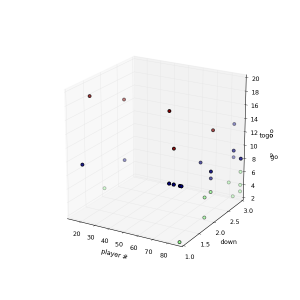
Peyton’s favorites (Click to enlarge)
This time you are looking are a cluster analysis of players Peyton passed too in the game of week 1. First cluster represent players passed to on 1,2 & 3 down with up to 6 yards. The second cluster the goto-guys which did go for medium yardage and finally the WOs able to get a bunch of yards on the board.
So with simple scripts (few lines of code – which can be reused) it is possible to abstract information from just play-to-play statistics. I guess mostly important to Defense Coordinators who would love to get some information on the fly with the press of a button 🙂
Categories: Personal, Sports • Tags: American Football, Analytics, Data Science, Machine Learning, Python • Permalink for this article
November 9th, 2013 • 2 Comments
A few line lines of Python code, a big CSV file, some help of Python Pandas, Suricate and about 20 minutes is all it takes to answer the following Question:
Who was Peyton Manning’s favorite receiver during the match-up between Denver and Baltimore in week 1 of the 2013 NFL season?
The answer is simple: Wes Welker 🙂 See the complete graph below…
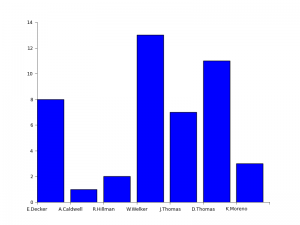
Peyton’s favorite (Click to enlarge)
Now it would be cool to find a source to stream the data into Suricate (which supports this) and get live up to date charts…but that is for another day.
Categories: Personal, Sports • Tags: American Football, Analytics, Data Science, Python • Permalink for this article
October 15th, 2013 • 2 Comments
With this blog post I try to summarize some key concepts/definitions of something called an Analytics-as-a-Service (AaaS). The AaaS – named Suricate – described in this post , was developed as part of my Masterthesis. The Masterthesis was about learning application/service behavior and then be able to abstract models from that, to create agile systems/strategies. This could reach from simple fault-detection up to reconfigurations (e.g. auto scaling) of the application/service instance of the platform (Cloud/whatever) it runs upon. Originally it was used to take data aggregated from DTrace using Python, parse models from it using scikit-learn, continuously compare (and update) models with new incoming data, and finally process/take actions. This process requires sometimes user interactions (from Data Scientist or whatever you wanna call them) as can be seen in the following diagram:
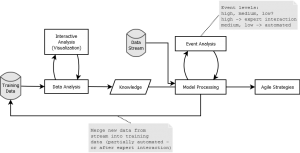
Learning Process (Click to enlarge)
Eventually, when my Masterthesis was done (with much more in it then just the development of Suricate in it – talking algorithms/concepts to create models etc), I thought it could serve some more general purpose. In short (tl;dr 🙂) Suricate:
- allows you to upload or stream data so the Service can aggregate it.
- allows a Data Scientist to perform Analytics and visualize the results.
- supports the processing and acting (trigger actions) on the analysis and thereby the creation of continuously adjusted agile Systems & Strategies based on up-to-date insights.
Concepts of an Analytics as a Service
The following diagram shows a conceptual overview of Suricate, which will be used to explain some key concepts of an AaaS.
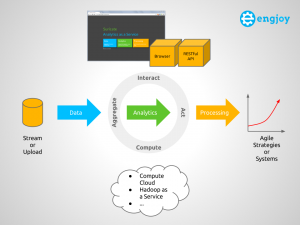
Overview of Suricate – Analytics as a Service (Click to enlarge)
Overall the four main concepts for an AaaS therefore are:
- Aggregate – Supplying user defined data: Stream data into the service or upload the data in an internal or external Storage (Object, Relational, etc). The data can then be aggregated, pre-processed and cached.
- Interact – Supplying user defined logic (this is where the IP is in – create marketplace for this if you want :-)): Use Python interactive scripting capabilities to perform analytics and visualize (visualizations are sometimes key to understanding :-)) the results. The Data Scientist can interact with the Service via a Web UI or REST API.
- Compute – Uses other services (potentially compute or things like Hadoop) to perform the computational aspect of the analytics.
- Act – Process the learned models and trigger actions on insights gained, to create agile Systems & Strategies.
Other example of AaaS are Quantopian or DataHero btw. There are plenty of other around, but most of them are focused on Business Analytics. But sometimes the streaming data & ‘Acting’ part is missing from all of them. When running Suricate one is first greeted with the overview page. Those ’tiles’ reflecting the main concepts of an AaaS:
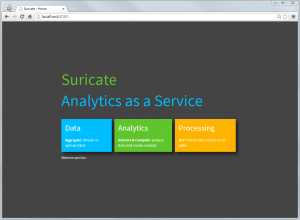
Suricate entry (Click to enlarge)
In the data page, files can be uploaded as objects and AMQP streams can be defined:
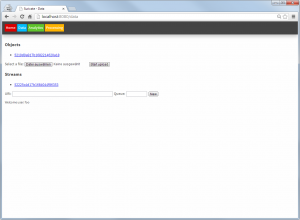
Suricate data sources (Click to enlarge)
In the Analytics part notebooks – just like with IPython – can be written. Within these notebooks toolkits such as matplotlib, scikit-learn or Python Pandas can easily be used. Using these toolkits models can be created within this part and stored again as objects (or even use them to retrieve/download data from somewhere). Also packages to enable faster computation of models can be integrated, as a full Python interpreter is at hands. Python is an ideal language for data processing/analytics and learning btw [1], [2] – although R could be integrated too.
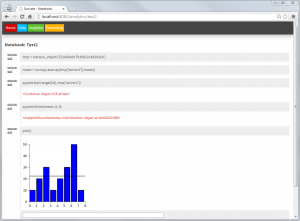
Suricate Analytics – model creation (Click to enlarge)
The Processing part looks similar to the Analytics part. Again notebooks can be created. But these notebooks now use the models created earlier, to compare them with new incoming data (from AMQP) streams and take actions accordingly.
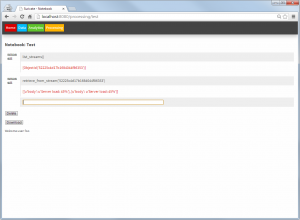
Suricate processing (Click to enlarge)
It is noted here that both the processing and the Analytics notebooks can be triggered externally (through an API), and therefore create a true continuously Analytics framework.
Suricate’s source code is available (without warranty – Open Source – in early stages etc. as it is mainly a Demonstrator/PoC for my thesis) on GitHub. Feel free to extent it etc. It happily runs on PaaS like OpenShift as it is an simple WSGI application.
Categories: Personal • Tags: Analytics, Data Science, DTrace, Machine Learning, Python • Permalink for this article
July 16th, 2013 • Comments Off on Learn Service Behaviour
This started off as just an idea in my head a while ago and soon become my Master thesis. The idea is to apply Machine Learning/Data Analysis methodologies to Data derived from tools such as DTrace. Based on the learned knowledge it would then be possible to create adaptive/agile systems. For example to balance out your workload as a service provider overnight. Or move your compute close to your data. Or to learn how to best configure your system (by using Software Defined Networking). Or to simple tune your threshold values in your monitoring system etc. Or you name it – it might be doable.
After finally finishing my Master thesis – doing that next to work is quite a challenge I can tell now 🙂 – I can certainly say that some stuff can indeed be learned. During the work on my thesis I sketched out a, in browser programmable (Python of course :-)), Analytics as a Service (I just like the acronym for it :-)) which can be used learn from Data derived from DTrace (See 1).
As a first step it is useful to select the resources you want to look at. The should have a relevance to the behavior of the applications and services. The USE Method demoed by Brendan Gregg might be a good start. Once you know what you want to look for it is possible to gather some data. For example using the DTrace consumer for Python (See 2), like I did. Cool think is now that thanks to Python you can send it around (pika), store it (MongoDB, sqlite) and process it (scikit-learn) easily. Just add a few API for abstraction, a rich web application for creating python notebooks and you have the Analytics as a Service.
Now we can work through the data with some simple steps.
- Step 1 – Analyze the time series you got with some first methods. This could reach from calculating means, averages, etc over smoothing or regression analyses to looking into correlations in the data. Now you will have a good knowledge of which time series are interesting for further analysis.
- Step 2 – Cluster the applications/services based on the data points to get an first overview of how they fit together. Again simple k-means clustering can be an initial step. Remember sometimes the simplest methods are the best 🙂
- Step 3 – Based on what has been learned till now try to apply mechanism to analyze the covariance/correlation between the applications/services. Once done you get a nice graph which represents behavior of your overall environment.
- Step 4 – Go beyond the simple and try to build Bayesian networks on what you got now. Go look at decision trees if possible to try build that adaptive/agile system.
- Step 5 – Well as usual the sky might actually be the limit.
Results of each of the steps can be seen as models which can be compared with new incoming data from DTrace. Based on the ‘intelligence’ of the comparison of the new date with the learn model (knowledge) the adaptive/agile system can be build. Continuously updating your learned model in the learning process is key – we don’t want to ‘predict’ the future using a crystal ball. This is just the tip of the iceberg of all stuff worked on and discovered in my Master thesis – but as usual – so little time so much to do 🙂 But maybe I’ll find some time soon to sketch out the learning process and share some details of what I was able to let the computer learn…
Categories: Personal • Tags: Analytics, Data Science, DTrace, Machine Learning, OpenSolaris, Python, SmartOS • Permalink for this article
March 24th, 2013 • Comments Off on Learning application behavior
I have been working for a while now on bringing together some very interesting topics. Machine learning/data analysis tools and the platform I like: SmartOS with it’s great DTrace tooling. This is a first post on this topics with some very early results 🙂
The following graph shows the dependencies between some processes (got way more in my dataset). The ones with ‘*_tracer‘ run within a zone. Whereas the ‘*_platform‘ are coming from the global SmartOS zone. To make it more complete also I/O of the platform are taken into account, so we do not just look at the processes. The graph shows the ‘links’ between the processes (e.g. python) & other data sources (iops):
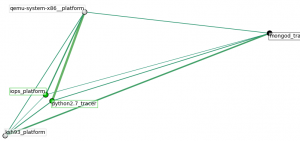
Inter-dependencies of proccesses
What happened within the time-frame of the training data was that another zone with an KVM VM instances got started, hence the ‘qemu‘ process running. First a cluster analysis was used to see the rough interdependence of the sources. The edges express the ‘strength’ of an link between data sources – this was inspired by this.
You can see that the start of a VM leads to some I/O operations, logically. The python process you can see has a strong link to the qemu process for no particular reason. This is because it was collecting data using the DTrace consumer. So it just happens that is was very active while the KVM got started. As said this is a first shot. Certainly the selection to which data sources to look at needs to be optimized. Plenty of possibilities there since I used DTrace to gather a fair amount of data.
Also it will be interesting to look at different application setups. This was data gathered during a VM start up. First experiments while looking at web severs (the httpd process and incoming tcp connections) already bring up different graphs. So why is this cool? When an machine can learn the behavior (graphs like above) it can identify misbehavior based on new incoming data from a DTrace probes. Also this could be used to tune the setup & configurations of a system.
Again these are very early results – just got excited and wanted to post something 🙂 Definitely the cluster analysis which is carried out needs to be tuned as well.
What was used to get this done:
And just for fun since I discovered this nice XKCD plotting extension to matplotlib – a graph which show the # of system calls per process over time in xkcd ‘style’:
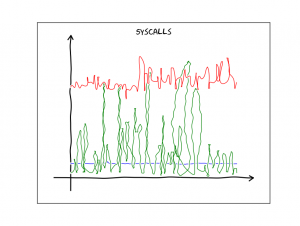
System calls per process over time
Categories: Personal • Tags: Analytics, DTrace, Machine Learning, Python, SmartOS • Permalink for this article









